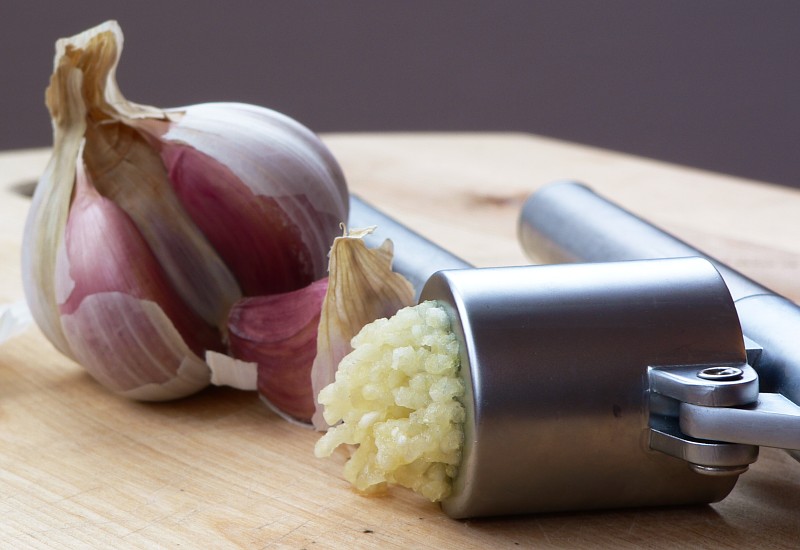Garlic

Garlic is a Green-Green food. Green-Green foods are very safe to eat as a regular part of a diet.
Category Quotes
Guideline related quotes related to Non-Starchy, Herbs and Green-Green throughout Geoff Bond's publications.
Eliminate added salt in cooking; replace with herbs and flavoring like lemon juice. ~Paleo in a Nutshell p.100
Eat at least 2 3/4 lbs of mixed salad and vegetables per day, consisting of "Green-Green” and “Green” foods. Of these, at least 3/4 lb should be mixed salad. Also include at least 5 cups of “Green-Green” leafy vegetables or 2 1/2 cups of other vegetables per week. ~Paleo in a Nutshell p.102
When cooking and eating, use herbs and flavorings like lemon juice. ~Paleo in a Nutshell p.103
Don't forget herbs and spices. They are full of healthful micronutrients (hence their pungent tastes and aromas). Get into the habit of using copious quantities of "Green" natural herbs and spices in all your dishes. Wean yourself and your family off processed sauces and table salt. ~Paleo in a Nutshell p.108
We know that there are many active compounds in the foods we eat, particularly fruits and vegetables. We are familiar with the "classic" micronutrients that have been identified over the past 100 years: vitamins A, B, C, and so on, and minerals like iron, selenium, zinc, and iodine. However, we now know that there are thousands of other micronutrient compounds that play a part in the smooth functioning of the body. In this book, we call them "background" micronutrients. For example, there is the family of carotenoids, of which there are over 600. They give the color to carrots, oranges, tomatoes, and melons. There is the phenol family with over 5,000 members. They too are present in all fruits and vegetables, and strongly present in tea, coffee, and wine. And there are the 7,000 terpene compounds, which are omnipresent in all plant foods, particularly in spices and aromatic herbs. We must not forget the thousands of bioflavonoids, yet another vast range of compounds that are essential to health. ~Deadly Harvest p.40
It is an interesting thought that in ancient times, no one had a means of boiling water. It was not until the invention of kiln-fired pottery in Egypt around 6000 B.C.76 Deadly Harvest that water could be heated and infused with herbs to give it flavor. Within a heartbeat of learning how to make pots, these inventive people also discovered how to ferment beverages to make forms of beer and wine. In short order, most civilizations adopted, or discovered for themselves, local variations on these basic beverages. ~Deadly Harvest p.75
Back in the Middle Ages, monks were experimenting with making alcoholic "elixirs" designed for medicinal purposes, with closely guarded recipes using fruits, sugar, herbs, and spices. We know these elixirs today as "liqueurs." ~Deadly Harvest p.77
Herbs and spices are usually rich in aromatic micronutrients, which accounts for their pungent flavor. This is all to the good, yet normally the quantities we eat are an insignificant part of the diet. For this reason (we suppose), the U.S. Department of Agriculture diet guide for 2005 has nothing to say about them. We do not give them a high profile either. ~Deadly Harvest p.116
Additional Quotes
Specific references to Garlic throughout Geoff Bond's publications.
Not everyone realizes that garlic salt is plain salt with garlic flavoring; regular stock cubes are over 50 percent salt; soy sauce is just liquid salt fermented with soybeans. ~Paleo in a Nutshell p.76
Try this quick (five-minute) method of cooking vegetables. Put a quarter-inch of water into a saucepan with a sliced clove of garlic and a bay leaf (or a pinch of oregano). Add a tablespoon of canola oil. The boiling water forms an emulsion with the oil. Add vegetables (fresh or frozen). Heat moderately with the cover on, but stir frequently, too. The vegetables cook fast, partly by boiling and partly by steaming. At the end, when the vegetables are close to done, heat vigorously and stir continuously until all the water has gone. They will be a beautiful golden brown when the water has evaporated. Always use plenty of herbs. As many vegetables soak up oil, this method greatly reduces the quantity of oil absorbed. ~Paleo in a Nutshell p.88
( . . . ) stir-fry can be ready frozen; season with garlic, lemon juice, and herbs. ~Paleo in a Nutshell p.89
For dinner, a (...) stir-fry can be ready frozen; season with garlic, lemon juice, and herbs. Note that we are escaping the tyranny of the "starter, main course, and dessert" regimen. Instead, it's just the one course. As ever, try to eat the vegetables before anything else. A glass of dry wine is okay, too. ~Paleo in a Nutshell p.89
Not all underground vegetables are starchy. For example, turnip and radish, which both originated in Asia, are non-starchy, as are bulbs such as onion and garlic from Asia and the leek from the Middle East. Corms such as Chinese water chestnut are also non-starchy. Unlike the starchy roots, they mostly get their bulk from another com pound called "inulin." ~Deadly Harvest p.56
Many primitive societies eat snails and their shell-less cousins, the slug. The idea to some minds seems grotesque, yet they are a valuable, easily collected source of food. In fact snails have been commonly raised and eaten in the Middle East and Europe for thousands of years. The French, of course, have made a national dish out of snails: "escargots" cooked in garlic and butter are even considered a delicacy. Snail and slug flesh conforms to the Savanna Model, although the French recipe is not ideal nutritionally. ~Deadly Harvest p.63